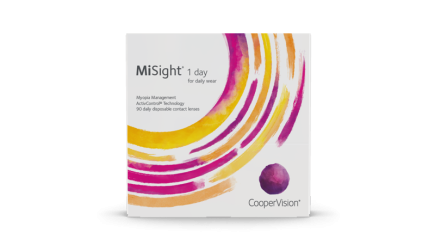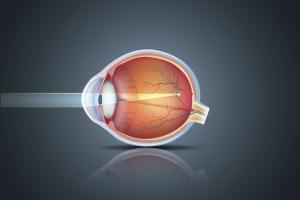Evidence-based medicine can provide a helpful guidepost for ECPs’ myopia treatment decisions.
Eye care professionals (ECPs) who practice evidence-based medicine will often rely on current, high-quality clinical research to help them determine the best course of treatment for their patients.1
Of course, treatments are rarely, if ever, 100% effective.2 This leaves clinicians to decide how well a treatment works based on the given evidence. They also need to balance the benefits against the risks, and then decide upon a course of action with the patient’s best interest always in mind.2
NNT: A Risk to Benefits Stat
One statistic in evidence-based medicine is Number Needed to Treat, or NNT. The NNT offers a measurement of the impact of a medicine or therapy by estimating the number.3 The NNT is an intuitive and simple way of estimating how likely it is that a treatment or medicine will help an individual person.3 NNT is often used in randomized controlled trials (RCT) and health assessments.4,5
In a nutshell, NNT provides an estimate on the number of patients that need to be treated for 1 patient to achieve a benefit, and in turn, prevent 1 additional adverse outcome. To calculate NNT, the absolute risk reduction (ARR) of a treatment needs to be determined first.2 The AAR is the difference in the event rates between a study’s treatment group and the control group.2 The NNT is the inverse of the ARR and can be calculated by taking 100 and dividing it by the ARR.2
For example, if a hypothetical heart attack prevention medicine is clinically found to reduce deaths by 50% (the ARR), this drug would have an NNT of 2 (100÷50=2).
Studies have reported that a lower NNT indicates a better chance of a health benefit.4 So if an NNT has a value of 1, each person who receives it would benefit.4 Conversely, if a treatment has an NNT of 200, this suggests that 200 patients would need to be treated for just one individual to benefit.4
Of course, NNT shouldn’t be used as the sole factor in treatment decisions.2,6 ECPs should also recognize when scientific study results, such as NNTs or risk reductions, are misinterpreted in published reports.2
A Look at NNT in Optometry
NNT has been recognized for its usefulness in many medical disciplines, including ophthalmic care.4,7,8
One landmark investigation, the Ocular Hypertension Treatment Study (OHTS), found topical ocular hypotensive medication was effective in delaying or preventing the onset of primary open-angle glaucoma (POAG) in individuals with elevated intraocular pressure (IOP), with treatment resulting in an approximate 50% decrease in the incidence of glaucoma.9 Previous investigations have given the OHTS’ findings an NNT value of between 20-24.4,5
Considering age-related macular degeneration (AMD), the Age-related Eye Disease Studyhad a reduced risk of progression from intermediate to advanced AMD by about 25%.10-12 One study that calculated NNTs for numerous large-scale ophthalmic randomized controlled trials gave AREDS an NNT value of (AREDS), and AREDS 2 found dry AMD patients who took a combination of antioxidants and zinc 17 for reducing AMD progression. 4,10,11
NNTs can also help clinicians determine treatments for other ocular conditions. For instance, one report listed an NNT of about 7 for antibiotic use in acute bacterial conjunctivitis.13,14
Looking beyond eyecare, NNTs, of course, are commonly considered in other medical disciplines. For example, the NNT for preventing 1 nonfatal heart attack in asymptomatic adults 40 years or older with statin medications has been estimated to be 217, while the NNT to prevent 1 nonfatal stroke has been given the value of 313.5,15
NNT’s Role in Myopia Control
When factoring in NNT into myopia treatment, a recent investigation by Dr. Mark Bullimore, et. al., found the potential benefits of myopia control by far outweighed the risks.5 His study gave myopia control a very low NNT value of between approximately 4 and 7 to prevent 5 years of visual impairment.5
Dr. Bullimore’s paper also noted fewer than 1 in 38 individuals would experience a loss of vision as a result of myopia control.5
Additionally, his investigation supported the need to treat myopia early, since each additional 1 diopter of myopia was tied to an increased risk of sight-threatening eye diseases.5
Myopia Control RCTs Show Strong Treatment Outcomes
For ECPs practicing myopia management, sound science and clinically-proven data can help make informed treatment decisions for patients.2

In the longest-running soft contact lens study among children ages 8-12 at the initiation of treatment, 90% of myopic eyes responded to MiSight®* 1 day contact lens wear† with a proportional treatment effect, meaning that younger and faster-progressing children receive the maximum benefit.16 Additionally, the 90% response rate equates to an NNT of 1.1 for MiSight® 1 day for myopia control in age-appropriate children.
Read more about NNT and how evidence-based medicine can help clinicians with myopia treatment decisions in this recent article by Dr. Kyle Klute. You can also discover more myopia management resources and learnings at CooperVision’s Online Success Center.
*Indications for Use: MiSight® (omafilcon A) daily wear single use Soft Contact Lenses are indicated for the correction of myopic ametropia and for slowing the progression of myopia in children with non-diseased eyes, who at the initiation of treatment are 8-12 years of age and have a refraction of -0.75 to -4.00 diopters (spherical equivalent) with ≤ 0.75 diopters of astigmatism. The lens is to be discarded after each removal.
†90% of myopic eyes respond to MiSight® 1 day treatment; ages 11-15 at start of wear, n=90.
1. Anderton P. Implementation of evidence-based practice in optometry. Clin Exp Optom. 2007 Jul;90(4):238-43
2. Klute KK. Evidence-based medicine can help clinicians with myopia treatment decisions. Healio. Dec. 20, 2023. https://www.healio.com/news/optometry/20231220/evidencebased-medicine-can-help-clinicians-with-myopia-treatment-decisions.
3. The NNT, Explained. The NNT. https://thennt.com/thennt-explained/
4. Varner P. Number-needed-to treat (NNT) analysis to ophthalmic clinical trials. Optom Vis Sci. 2006 Dec;83(12):919-30.
5. Bullimore MA, Ritchey ER, Shah S, et al. The risks and benefits of myopia control. Ophthalmology. 2021 Nov;128(11):1561-1579.
6. Chong C, Tomlinson G, Chodirker L, et al. An unadjusted NNT was a moderately good predictor of health benefit. J Clin Epidemiol. 2006 Mar;59(3):224-33.
7. Thomas R, Muliyil J, Paul P. Knowledge of epidemiology and statistics for an ophthalmic practitioner. J Indian Med Assoc 2001;99: 561–4.
8. Thomas R, Kumar RS, Chandrasekhar G, Parikh R. Applying the recent clinical trials on primary open angle glaucoma: the developing world perspective. J Glaucoma
2005;14:324–7.
9. Kass MA, Heuer DK, Higginbotham EJ, et al. The Ocular Hypertension Treatment Study: a randomized trial determines that topical ocular hypotensive medication delays or prevents the onset of primary open-angle glaucoma. Arch Ophthalmol. 2002 Jun;120(6):701-13.
10. AREDS Group. A randomized, placebo-controlled, clinical trial of high-dose supplementation with Vitamin C and E, beta carotene, and zinc for AMD and vision loss: AREDS report no. 8. Arch Ophthalmol. 2001 Oct;119(10):1417-36.
11. AREDS Group. A randomized, placebo-controlled, clinical trial of high-dose supplementation with Vitamin C and E, beta carotene, and zinc for AMD and vision loss: AREDS report no. 9. Arch Ophthalmol. 2001 Oct;119(10):1439-52.
12. Chew EY, Clemons TE, Agrón E, Sperduto RD, Sangiovanni JP, Davis MD, Ferris FL. Age-Related Eye Disease Study Research Group. Ten-year follow-up of age-related macular degeneration in the age-related eye disease study: AREDS report no. 36. JAMA Ophthalmol. 2014 Mar;132(3):272-7
13. Sheik A, Hurwitz B. Antibiotics versus placebo for acute bacterial conjunctivitis.Cochrane Database Syst Rev. 2006;(2):CD001211.
14. Topical Antibiotics for Bacterial Conjunctivitis. The NNT. Topical Antibiotics for Clinical and Microbiologic Cure of Bacterial Conjunctivitis – TheNNTTheNNT. Accessed July 8, 2022.
15. R. Chou, T. Dana, I. Blazina, et al. Statins for prevention of cardiovascular disease in adults: evidence report and systematic review for the US Preventive Services Task Force. JAMA, 316 (2016), pp. 2008-2024.
16. Chamberlain P, Bradley A, Arumugram, B, et al. Long-term Effect of Dual-focus Contact Lenses on Myopia Progression in Children: A 6-year Multicenter Clinical Trial. Optom Vis Sci. 2022 Mar 1;99(3):204-212.








